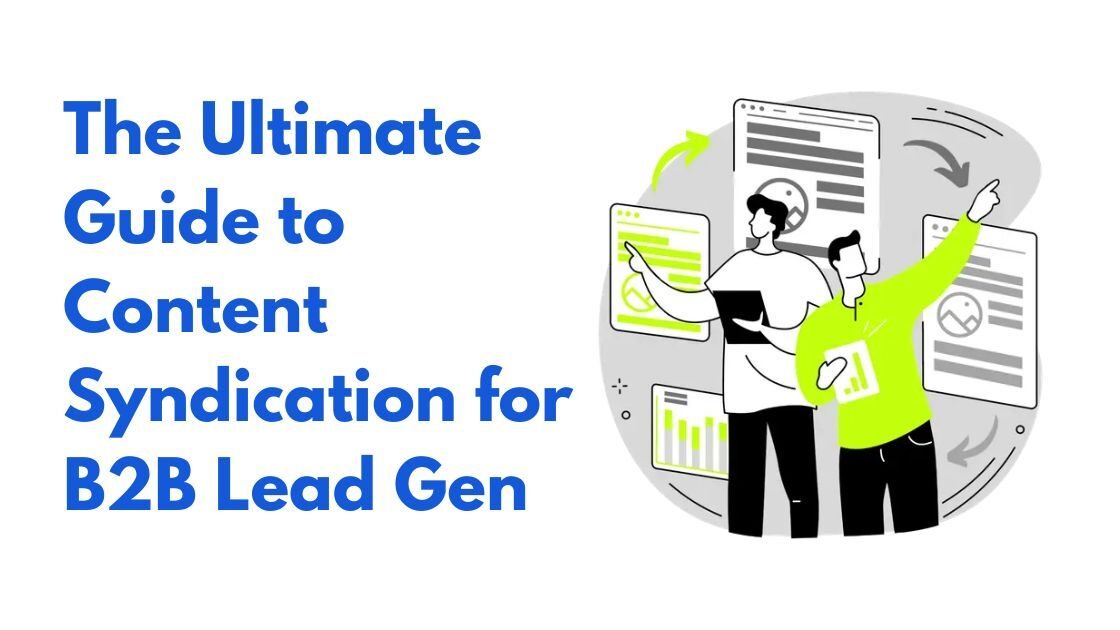Content Syndication for B2B Lead Gen has become a critical strategy in modern marketing.
As B2B marketers continue to search for ways to expand their reach and generate high-quality leads, content syndication has proven to be an effective, scalable approach.
Consequently, by syndicating your content on authoritative third-party platforms, you not only increase brand visibility but also drive targeted traffic to your website, ultimately boosting lead generation efforts.
In this comprehensive guide, we will explore everything you need to know about content syndication in 2025.
From understanding its benefits to executing it strategically, this guide is packed with facts, data, and actionable insights to help you optimize your content distribution and lead-generation efforts.

What is Content Syndication for B2B Lead Gen?
Content syndication refers to the practice of republishing your content—such as blog posts, whitepapers, case studies, and other valuable resources—on third-party platforms, websites, and networks.
Consequently, this strategy aims to distribute your content to a wider audience, increase brand awareness, and capture qualified leads.
Furthermore, in the B2B space, content syndication is a powerful tool for attracting decision-makers who may not have been aware of your brand or services otherwise.
Additionally, it supports the entire marketing funnel, from creating awareness to nurturing leads through informative, high-quality content.

Why Content Syndication for B2B Lead Gen is Crucial in 2025
The need for content syndication is even more crucial in 2025 as businesses face evolving challenges in attracting leads.
Here are some reasons why syndicating content is indispensable for your B2B lead-generation strategy:
- Increased Exposure to Targeted Audiences
According to Statista, there were approximately 4.8 billion internet users globally in 2024, emphasizing the vast potential of reaching a diverse audience. By leveraging content syndication, you can ensure that your message reaches potential clients and stakeholders on established, trusted platforms. - Boosts SEO and Generates Backlinks
When you syndicate your content on high-authority platforms, you gain valuable backlinks, which are a key ranking factor for SEO. Backlinko states that backlinks continue to be one of the top three factors influencing Google’s rankings. Content syndication can improve your search engine visibility and organic traffic, enhancing your overall lead-generation results. - Cost-Effective Lead Generation Strategy
Content syndication offers a budget-friendly alternative to paid ads. While platforms like LinkedIn and Google Ads are effective, they can be costly. Content syndication allows you to organically grow your audience without breaking the bank, making it a sustainable and cost-efficient method. - Establishing Industry Authority and Trust
Republishing content on established third-party platforms helps establish credibility. According to Content Marketing Institute, 61% of B2B marketers report that content marketing increases brand authority. Content Syndication for B2B Lead Gen can further elevate your company’s reputation by associating your content with high-quality, authoritative sources. - Nurturing Leads Through the Funnel
Content syndication isn’t limited to just top-of-funnel awareness; it can be used to nurture leads through each stage of the buyer’s journey. According to Demand Gen Report, 47% of B2B buyers consume 3-5 pieces of content before engaging with a sales representative. Syndicating long-form content like whitepapers, reports, and case studies can effectively nurture leads, keeping them engaged and moving down the sales funnel.

How to Implement Content Syndication for B2B Lead Gen
Now that we understand the importance of content syndication, let’s look at how to implement it effectively to achieve your lead-generation goals.

1. Identify Your Target Audience
For successful Content Syndication for B2B Lead Gen, identifying and understanding your target audience is key.
According to BreadCrumbs, 70% of B2B buyers expect businesses to understand their specific challenges and pain points.
Therefore, by creating detailed buyer personas, you can ensure that your syndicated content resonates with the right decision-makers.

2. Select the Right Content for Syndication
Not all content is suited for syndication. The best content to syndicate includes:
- Educational Content: This helps your audience solve problems and answers their questions.
- In-Depth Reports and Whitepapers: These establish your authority and position your company as an expert.
- Visual Content: Infographics, case studies, and presentations are more likely to be shared and engaged with on platforms like SlideShare.
Content syndication works best when you share content that educates, informs, and adds value to your audience’s experience.

3. Choose the Best Platforms for Syndication
The platforms you choose for content syndication can make a significant impact on your success. Some of the most effective platforms include:
- LinkedIn: With over 1 billion active users (LinkedIn), LinkedIn is one of the best platforms for sharing thought leadership, blog posts, and case studies to a professional audience. LinkedIn Pulse and LinkedIn Groups are powerful tools for syndicating B2B content.
- Medium: Medium, with over 170 million monthly active users (Statista), remains an excellent platform for republishing articles and engaging with readers across various industries.
- SlideShare: As a visual-centric platform, SlideShare has over 80 million unique visitors monthly (LinkedIn), making it an ideal space for sharing presentations, infographics, and reports.
- Scoop.it: This platform allows businesses to discover and share content while expanding reach. Research shows that businesses using content curation platforms like Scoop.it can boost web traffic by up to 50% (Content Marketing Institute).
- Business 2 Community: This platform is a trusted space for B2B marketers to share content and engage with decision-makers in industries like marketing, business, and leadership.

4. Use Automation Tools for Efficiency
Content syndication can be time-consuming without the right tools.
Automating the process can save you time and help you scale your efforts.
Platforms like:
- HubSpot: HubSpot’s marketing automation tools help schedule and distribute content across multiple channels.
- ContentStudio: This platform simplifies the process of sharing content on various social media platforms and blogs.
- Scoop.it: Known for content curation, Scoop.it also helps automate the syndication process.

5. Measure the Effectiveness of Syndicated Content
Tracking and analyzing the performance of your syndicated content is crucial for refining your content syndication strategy.
Key metrics to measure include:
- Traffic: Use Google Analytics to monitor how much traffic your syndicated content is driving to your website.
- Lead Generation: Platforms like HubSpot allow you to track how many leads are coming from syndicated content.
- Engagement: Use tools like BuzzSumo to measure engagement (likes, shares, comments) with your syndicated content.
- Conversion Rate: Tools like Optimizely can help you assess how effectively syndicated content converts visitors into leads.
Best Practices for Content Syndication for B2B Lead Gen
To maximize the results of your Content Syndication for B2B Lead Gen efforts, follow these best practices:
- Optimize for SEO
Ensure your content is optimized for search engines before syndicating. Moz states that more than 50% of search rankings depend on factors like keyword optimization and on-page SEO (Moz). - Include Clear Calls to Action (CTAs)
Adding well-placed and compelling CTAs to your syndicated content can increase conversion rates by 20% or more (Unbounce). - Repurpose Content
Repurpose blog posts into other formats, such as infographics and videos, to cater to a wider audience. Salesmate reports that 66% of B2B marketers find visual content more effective in generating leads (Salesmate). - Track and Optimize Results
Continuously track the performance of your syndicated content to identify what works and refine your approach over time.
Conclusion
Content syndication is a powerful tool for B2B lead generation in 2025, offering businesses an affordable and effective way to expand their reach, boost brand visibility, and attract high-quality leads.
By strategically selecting platforms, optimizing content, and measuring your results, you can create a successful content syndication strategy that drives significant results.
Start implementing these strategies today and watch your B2B lead generation efforts thrive!
Additionally, Trigacy is your trusted partner in achieving scalable and effective lead generation. By combining tailored strategies, high-quality content, and access to high-authority platforms, Trigacy ensures your content reaches the right audience, driving engagement and conversions.






